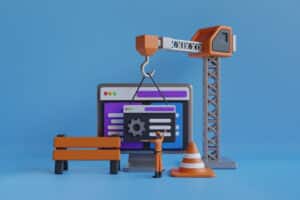Email marketing remains a powerful tool that businesses can use to connect with their audiences, nurture leads, and drive sales. However, sending generic, one-size-fits-all messages to your entire subscriber list may not be as effective as some alternatives. To truly engage with your audience and maximize the impact of your email campaigns, we recommend that you segment your emails.
Email segmentation involves dividing your main contact database into smaller, more targeted lists based on specific factors like demographics, behavior, interests, and preferences. By sending content that is personalized and relevant to each segment, the more likely you are to improve open rates, click-through rates, and overall campaign performance. Let’s explore how you can apply this strategy by reviewing the types of lists you may create.
1. Demographics
Segmenting your emails based on demographics lets you tailor your messaging based on unique characteristics like age.
Example: a clothing retailer uses age to segment their database for different fashion promotions. A subject line like “Trendy Styles for Millennials” may resonate more with younger subscribers, while “Timeless Classics for Mature Audiences” may appeal to older ones.
2. Interests and Preferences
Understanding the interests and preferences of your subscribers allows you to send targeted content that they’re more likely to engage with, and subsequently more likely to agree to purchasing.
Example: a travel agency separates its contacts based on travel destinations and vacation preferences. Subscribers who are interested in beach getaways receive unique emails about tropical destinations, while adventure enthusiasts get recommendations for hiking excursions and safari tours.
3. Purchase History
Similar to playing to your leads’ interests, you may also choose to segment your emails based on the products and services they’ve already bought from you. This allows you to upsell and cross-sell other solutions you think they’ll enjoy.
Example: a two-way radio supplier sends emails that promote accessories and extended warranties to its dealers who recently placed orders for specific radio models.
4. Lifecycle Stage
Segmenting your emails according to where subscribers are in the buyer’s journey (more on that below) allows you to deliver content that helps them identify one of three things: a) that they have a problem that needs solving, b) what options there are to solve that problem, or c) whether it’s finally time to make a purchase decision.
Example: a software company segments their list into new leads, active trial users, and paying customers. New leads receive educational content, active trial users get product demos to nurture their interest, and paying customers receive exclusive offers and upgrade opportunities.
5. Engagement Level
Segmenting contacts by engagement level means that you’re sending specific messages to groups of people based on how often they open and click through your emails. Those who open frequently could generate a higher lead score and thus receive more updates and exclusive content, while those who haven’t opened in a while may benefit from fewer, shorter emails that focus more on reigniting their interest.
Example: a medical technology company shares press releases and ebooks with leads who repeatedly open their emails, while they send brief messages that promote their products to those who only open periodically.
A Note About Lead Scores
Lead scoring is when you assign a numerical value to a lead based on their engagement with your company. As we just mentioned, this can include how many times a lead opens an email, whether they click any links in that email, and what pages on your website they visit as a result. Each completed action will generate a numerical value that is added to your lead’s overall score, and may vary based on the type of email automation or customer relationship management (CRM) software that you use.
You can often assign higher scores to leads who indicate strong interest in making a purchase, like frequently visiting your website, consistently opening your email campaigns, or downloading content.
Here’s why lead scores are important.
First, they help businesses allocate marketing and sales resources more effectively by prioritizing which leads are more likely to convert.
This helps marketers tailor their messaging and communication strategies based on the specific needs and interests of each lead. Marketers can send relevant and personalized content that resonates with their audience, ultimately leading to higher engagement.
Applying lead scores keeps your sales and marketing teams on the same page by giving them a common framework to evaluate their leads, allowing for smoother handoffs and higher conversion rates.
Finally, scoring helps businesses identify high-value customers who are worth investing additional time and resources. Knowing who has a higher likelihood for repeat purchases and long-term engagement makes it easier for you to continue selling key products and services to them.
6. Lead Preferences
It’s important to respect and honor the preferences that your leads have about how often you communicate with them, and about what topics. Not only does this tie into the CAN-SPAM Act, but it also gives your subscribers the option to customize the content they receive — which basically does the job of segmenting your emails for you!
Example: a company that offers training on fleet vehicle maintenance asks their contacts if they prefer to hear from them about upcoming classes, certification, industry news, or changes to fuel system requirements.
7. Purchase Intent
Identifying and segmenting subscribers based on purchase intent allows you to send targeted campaigns that prompt would-be customers to take the final step.
Example: an online retailer segments their list by cart abandonment behavior and sends automated reminder emails with personalized product recommendations to encourage completion of those purchases.
8. Customer Lifetime Value (CLV)
As we mentioned with lead scoring, it’s important to note your high-value customers. CLV prioritizes your marketing efforts by focusing on those who are likely to generate significant revenue for you over time. Offering them VIP perks, exclusive discounts, or personalized recommendations can reinforce these long-term relationships and maximize your ROI.
Example: a company offers a partner program to incentivize other industry leaders to join them in cross promotions. These promotions generate revenue for the company and market visibility for its partners.
Now that we’ve discussed the ways that you can segment your database, it’s important to understand how this segmentation affects your buyer’s journey.
The Buyer’s Journey
The buyer’s journey is the process in which a potential customer becomes aware that they have a problem, researches possible solutions, and ultimately chooses to purchase one.
This three-stage process of “awareness, consideration, and decision” is crucial for marketers as it allows them to create email campaigns that reflect these stages. When done well, these emails push leads to your website to learn more about you.
Here’s how the buyer’s journey relates to the segments we touched on above.
Different demographic groups may have specific problems they’re looking to solve. Segmenting your emails can help you engage with them on the issues, products, and services that matter most.
Knowing the interests, preferences, and purchase intent of your leads allows you to understand what they’re looking for, so that you can provide them with options that meet those needs. Then, you can use their responses to your emails to determine whether respective leads are casually entertaining different solutions, actively looking to buy, or about to make their final decisions.
As for your current customers, their past purchase behavior automatically gives you valuable insights into their preferences and buying habits. You’ll know what solutions these customers are already interested in, which makes it easy to market recommendations about similar products and services they may also want.
By applying the concept of the buyer’s journey when you segment your emails, you can create a more personalized and engaging experience for your leads that drives conversions and fosters customer loyalty.
Let’s Talk About Segmenting Your Emails
Email segmentation is a powerful strategy for improving the effectiveness and ROI of your digital marketing. By using segmentation like the examples above, you can deliver personalized and relevant content that resonates with your audience.
Does this mean that you have to segment your emails based on all of the options above? Of course not! You’ll want to take a look at how your current contact database is arranged to determine which ones are the most relevant to you.
If you have questions about how to do that, or about other strategies and tools for effective email marketing, we want to hear them! Click the link below to schedule some time with one of our Fractional CMOs.





